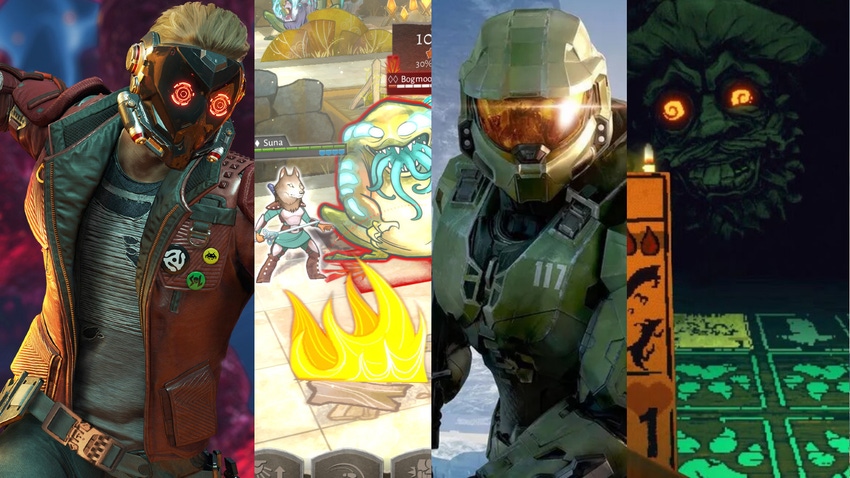Game Developer's Best of 2021: The top 10 games of the year
From innovative and introspective indies to triple-A games that hit just right, here's the Game Developer Staff's picks for the top games of 2021.

Following 2020 where our favorite games were clearly defined by themes of community and togetherness, the common thread throughout our best games of 2021 is harder to define. For us here at Game Developer, the conversation about which games to feature on our top 10 list was just as complex.
Our favorite games told stories in new ways, embracing narrative design that intertwines strong gameplay with evocative stories. They navigated what it means to be human, and found thoughtful ways of exploring the complicated emotions we've felt ourselves or experienced through others. Our favorite games were end-to-end fun, offered worlds that we were more than happy to lose ourselves in for hours upon hours at a time, and that we still thought about long after the credits had rolled.
So while there's no one theme that defined this year in games for us, both this staff-wide games of the year list and the personal GOTY lists coming over the next few weeks offer a look into what stuck with us this year by trying and excelling at something new, by making us think and reflect on how stories are told, or by simply delivering an exceptional experience that propelled the medium forward.
(In alphabetical order,)
Genesis Noir (Feral Cat Den)

It’s said that writing about music is like trying to dance about architecture. Similarly, finding words for Genesis Noir is not easy. The game is not so much a linear narrative experience so much as a collection of interactive illustrations, like a pop-up book that invites the player to poke and prod each scene as a child might test out a new toy.
But it’s the tentative moments in Genesis Noir that make the game, affording an opportunity to explore the game’s relationship between its themes and puzzles. In one level, I tapped a cluster of clouds, filling a pond with rain until it burst with lotus flowers. In another, I helped prehistoric simple-celled organisms find a mate. In yet another, I finely-tuned a set of dials to launch a particle collider. While seemingly unconnected, these scenes are all part of a greater cosmic poem about fate, desire, and the expansion of the universe. Is it better to have loved and lost or never loved at all? The question takes on existential weight as the story’s hero, No Man, sets out to stop the murder of his paramour Miss Mass. Does he indulge his lust for the jazz singer and set off the chain of events that result in the Big Bang? Or does he let her go, sparing her life but subverting the would-be blossom of conscious existence?
Whatever the choice you make in Genesis Noir, the journey will be scenic. The game’s evocation of 1930s film noir and classic jazz is strikingly chic. But beneath its indulgent exterior is a romantic tragedy that I’m still mourning, all these months later. - Holly Green, Community Editorial Coordinator
Halo Infinite (343 Industries)

I'm a cynical husk of a human being, so there are few things in life that make me genuinely giddy. Launching a fusion coil into an unsuspecting chump while mid-flight in Halo Infinite is one of them. In terms of pure gameplay, Halo Infinite has everything you could want from a shooter.
The multiplayer portion is crystallized chaos, a smorgasbord of intensely engaging game modes that made me realize how much I'd missed playing an objective other than 'become the last person standing.' Each game is filled with moments of bedlam and lunacy that defy description, with all manner of grenades, weaponry, vehicles, and power-ups combining to create a combustible gourmet soup that we'll all be slurping down for years to come.
The campaign is equally madcap. Although I'm not entirely sold on the open-world aspect quite yet -- for me, Infinite's standout moments take place during its more on-rails segments -- the moment-to-moment gameplay when you're taking down a base or clobbering a boss is tense, unpredictable, and outrageous in the best conceivable way. Halo is at its best when it leans into being an anarchic toybox, encouraging players to experiment with its tools of destruction and bonkers physics to answer questions like: can you grapple onto an exploding Warthog while it tears through the skies to turn the Master Chief into a human missile?
The answer, of course, is a triumphant yes. - Chris Kerr, News Editor
Hitman 3 (IO Interactive)

I didn't understand the joy of the most recent Hitman trilogy until Hitman 3. The whole concept of the gruff, nameless assassin with a barcode tattooed on the back of his bald head wasn't appealing to me, on the surface.
But for whatever reason--probably because of the hilarious clips of the game that I saw on Twitter--I decided to finally give this game a real shot, and I'm so glad I did. Of all games I played this year Hitman 3 is the most playful and surprising. It's a game that begs the player to share with others the ornery situations you subject Agent 47 to. Hitman 3 encourages you to get up to no good, and provides players with hilarious, clever ways to avoid getting into trouble with the grownups. And randomly flipping unsuspecting bystanders over railings will never get old. - Kris Graft, Publisher
Inscryption (Daniel Mullins Games)

Inscryption is a love-letter to the collectible card game—not just how good the mechanics are, but to way the game industry has adapted its core mechanics to fit in a number of other game genres.
It's a weird, metatextual adventure that manages to be unsettling, compelling, and nerve-wracking all at once. It's so hard to even describe what happens in this game without spoiling the wonderful surprises that come with it, but developer Daniel Mullins Games has made the surprises so wonderful it's worth calling out that they're worth not sharing in advance.
It's a fun card game that also has the vibe of you and your friends whispering weird secrets about Pokémon Red & Blue on the recess playground. Except in this game, Mew is hiding under the truck by the S.S. Anne. And it's maybe going to try and kill you for real. - Bryant Francis, Senior Editor
It Takes Two (Hazelight Studios)

There's a charm to couch co-op that you don't get to see often now-a-days, and It Takes Two has that charm in spades. Developed by the practiced couch co-op team at Hazelight Studios, It Takes Two follows the story of divorcing parents May and Cody after their daughter unwittingly turns the two of them into a pair of puppets that must learn to work together to both find their way home and back to their bodies.
The larger-than-life trek follows their journey from a precarious garden shed, through a bee and rodent-ridden backyard, and into the chaos of a child's playroom, with each individual stage granting the pair unique but complementary abilities to help navigate the obstacles peppered throughout the world. In one level for example, Cody can shoot nails into a board to create a path for May to swing across, while another gives May the ability to walk up walls and Cody the power to shrink or enlarge at will. In all cases, the dozen or so powers granted to each across the game require teamwork and communication from players in order to move forward.
Each level is more than just the platforming and puzzles needed to progress too; throughout every world are tons and tons of small details, interactive objects, and mini-games that carry that same feeling of communication throughout even those small moments, make exploration its own reward, and keep the game feeling fun at every turn.
We'll ignore the fact that May and Cody are arguably bad people who, at one point, decide making their daughter cry is their only way towards freedom (and do so through means that would be exceedingly graphic and violent if the characters weren't puppets.) The story is, at times, questionable, but the excellence of the gameplay, the world, and overarching journey more than makes up for this particular shortcoming. - Alissa McAloon, Editor-in-Chief
Loop Hero (Four Quarters)

Loop Hero is an idle game that requires your attention. So maybe it's just sort of an idle game. But enough with trying to pigeonhole this game into a genre. Loop Hero is an expertly-designed arena of risk and reward, where in order for you to succeed, you need to make things difficult for yourself (but not too difficult, lest you fail).
Born out of the three-day Ludum Dare game jam, Loop Hero was made from absolute scratch (as "start with nothing" was the theme of the jam that year), making the game feel as if the Four Quarters team caught lightning in a bottle. Part board game, part RPG, and part deck-builder (with a bit of city-building thrown in for good measure), Loop Hero fits its influences together like a jigsaw puzzle, and the result is wholly unique. Tie everything together with a fantastic pixelated art style and moody chiptune music and you have a game that will be remembered for a long time to come. - Kris Graft, Publisher
Marvel's Guardians of the Galaxy (Eidos Montreal)

There was a minute there in the 2010's where the direction of action adventure games was a push into what you'd call "setpiece" game design. The 2013 Tomb Raider reboot and 2014's The Last of Us showed the power of games that relied on big spectacle (but relatively shallow combat).
Games like these faded off the vine somewhat, giving way to either open-world extravaganzas like Assassin's Creed or leaning into deep, expansive combat systems reminiscent of Dark Souls. But Eidos Montreal kept a hand in the setpiece game design toolbox, and managed to turn out one of the year's best narrative adventures as a result.
Marvel's Guardians of the Galaxy is a slick, funny, mind-blowing game that is willing to whip up new mechanics for players only to toss them away a scene later for the sake of a joke. It'll pause the action to let you and your teammates fight over a space phone tree, whip up a cool anti-gravity sequence that has nothing to do with the rest of the game, and break out laser-precise flight sequences that add to the spray-painted van art vibes the rest of the game has to offer.
Beneath those systems and setpieces is a well-told story about grief, family, and trauma that feels extra resonant after the devastating two years we've been through. Big games are often accused of having no heart or soul. We're glad to report Guardians of the Galaxy isn't one of them. - Bryant Francis, Senior Editor
Metroid Dread (Mercury Steam, Nintendo EPD)

You may recall the story of how in the early days of the development of the seminal Mario 64, the development team, including Shigeru Miyamoto, concentrated almost solely on making Mario's character fun to control. Playing Metroid Dread, I wonder if the developers at MercurySteam took the same tack, because Samus is inherently entertaining to make run, slide, and roll across the screen.
It's this satisfying control over the character that provides the connection between the player and the world of Metroid Dread, acting as an anchor for all the other gorgeously-designed aspects of the game. The nigh unstoppable EMMIs that do their part to strike dread in the player; the boss battles that reward mastery; level design that serves Samus' abilities, bringing her powers to the forefront. As much as we're looking forward to the next Metroid Prime, Metroid Dread made us say "Prime who?"
It's an outstanding achievement whose dev team deserves all the credit, including the members who didn't get any. - Kris Graft, publisher
Sable (Shedworks)

Maybe it's because of the pandemic, or maybe it's because I'm *whisper it* getting older, but my playing habits have changed dramatically of late. Despite initially being excited about the onslaught of all-action, big-budget blockbusters that were slated to take 2021 by storm at the start of the year, as the months ebbed away I found myself increasingly drawn to those titles that shunned bloody, burly conflict in favor of empathy and compassion.
Sable, an open-world exploration game about a young person struggling to find their place in a wondrous and desolate alien world, delivers both of those things and so much more. Comparisons to The Legend of Zelda: Breath of the Wild come easy, and while there are undoubtedly similarities between the two, I'd argue they don't quite hit the mark.
In Shedworks' soaring Moebius-infused adventure there are no cataclysmic stakes, chosen ones, or world-ending threats to vanquish. Instead, the challenges players face spring from the inner-turmoil of a normal person searching for themselves amid a sea of uncertainty. As Sable, players must use pacifist powers that unlock with youth and fade with time to sweep across crimson dunes, scale crumbling ruins, glide between yearning chasms, and help those in need simply because they can.
Each of those endeavors provides an opportunity to learn and grow, granting a deeper understanding of the strange world Sable inhabits and the roles we can play within it. There is beauty and mystery here in spades, but Sable shines because its underlying message is one of empowerment, expression, and self-acceptance. - Chris Kerr, News Editor
Wildermyth (Worldwalker Games)

Worldwalker Games' Wildermyth is a marvel of storytelling, and the rare game that actually manages to capture the magic of playing a tabletop roleplaying game thanks to both its visuals and renowned focus creating heroic stories. Wildermyth itself is merely the tool through which those tales of heroism take form. Players are given freedom to define the traits and decisions their characters make throughout a years-long campaign, and those features weave into the loose overarching narrative to create something truly unique.
Your hotheaded goofball mystic may form a lasting rivalry with a party member and see combat bonuses whenever that rival shows them up, or your bookish leader warrior may stumble upon something truly wondrous in the woods and walk away forever changed by the encounter, their arm turned to stone and unable to hold their two-handed sword but now functioning as a natural, crystalline shield that protects them in combat. Even when these random encounters or events repeat down the line, the stories and personalities you've built up for your characters make each and every decision feel fresh and unique.
The particular way Worldwalker Games approaches magic in Wildermyth alone deserves praise. Mystics, one of the three playable classes that can evolve down many paths, source their magic from the items scattered around each combat map, creating explosions of wood or leaping whips of fire. It's a system that uniquely complements the grid and turn-based combat of Wildermyth, and brings a deeper level of strategy to the already fun, and often challenging but rewarding combat encounters, ultimately resulting in one of the best games I've had the pleasure of playing. - Alissa McAloon, Editor-in-Chief
Read more about:
FeaturesAbout the Author(s)
You May Also Like









